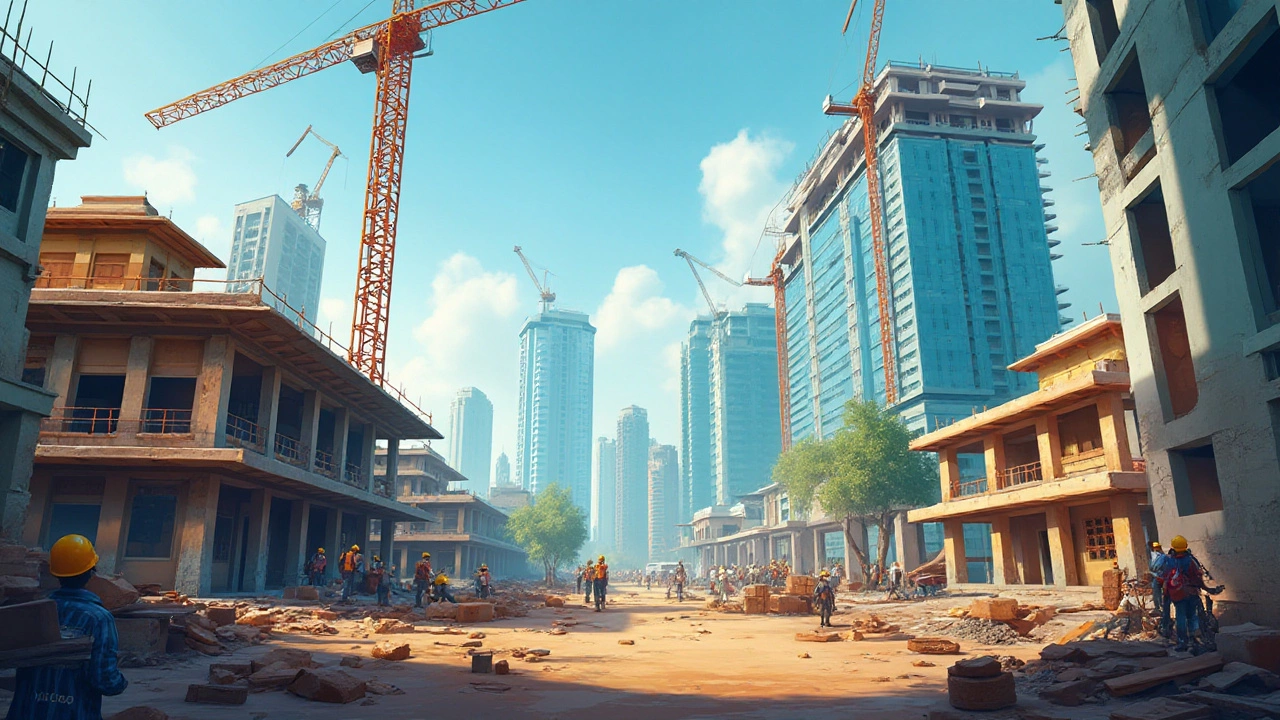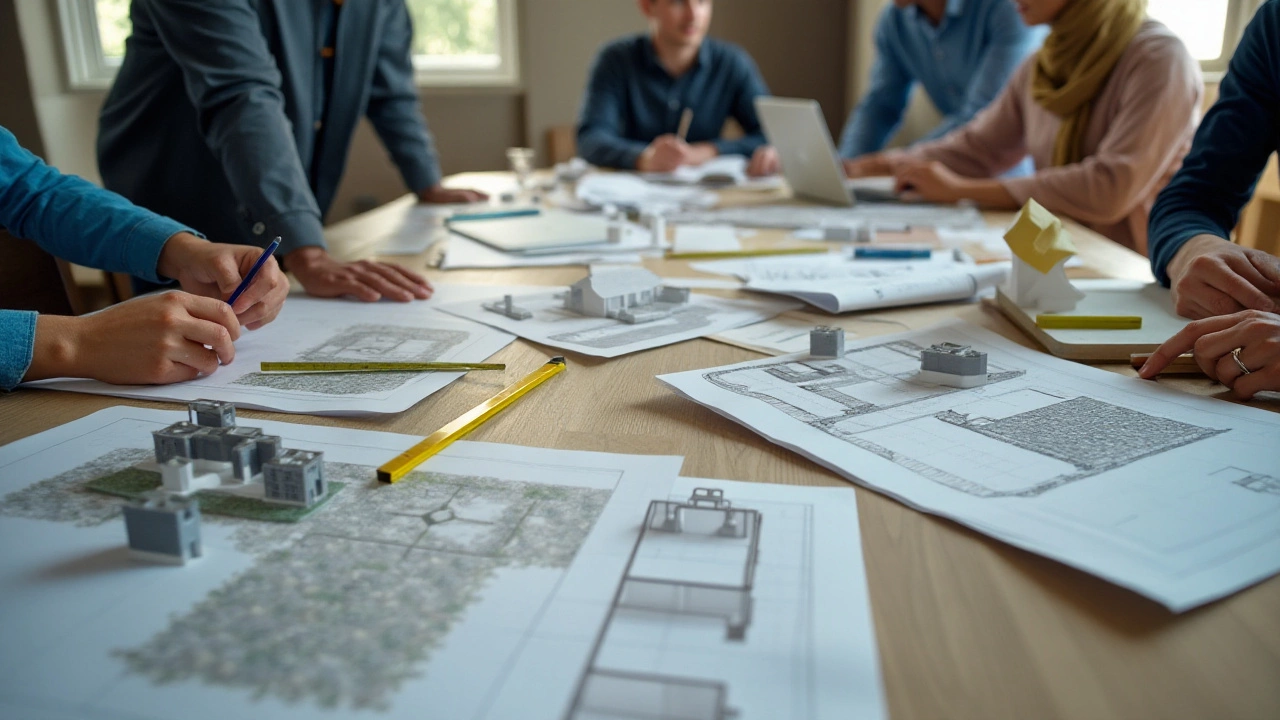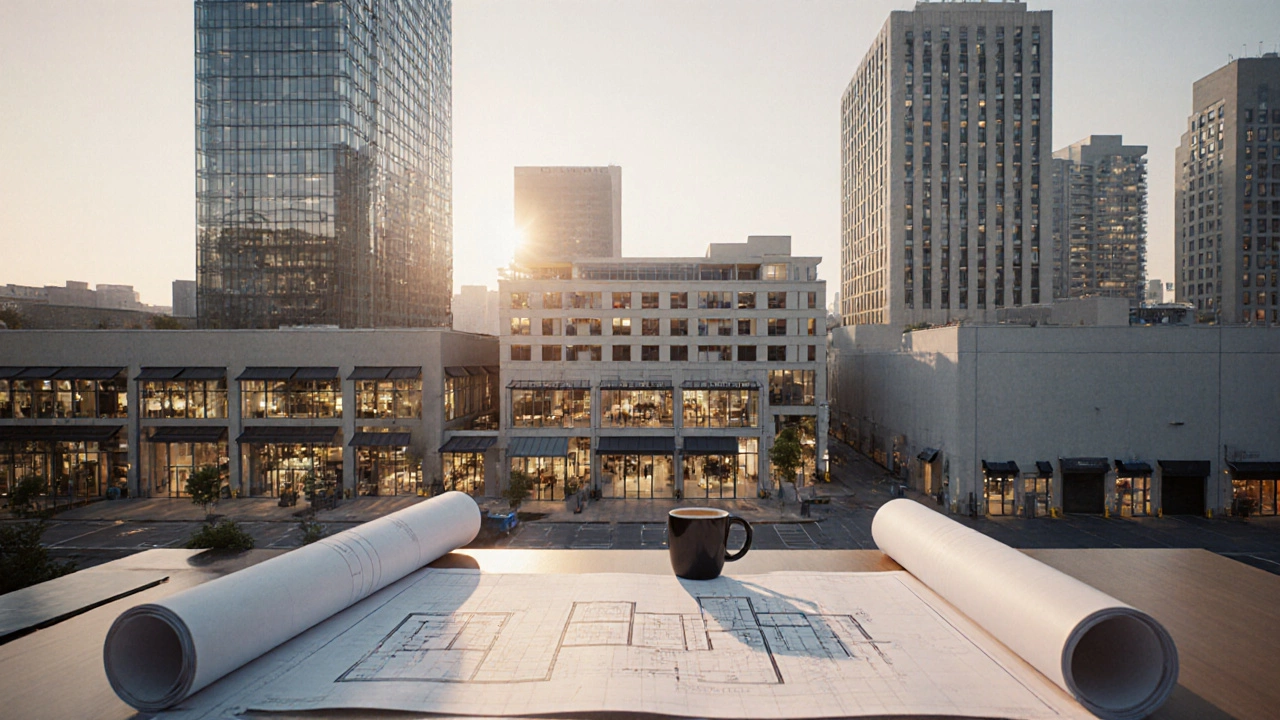Key Differences Between Residential and Commercial Construction

In the world of construction, the distinction between residential and commercial projects might seem apparent at first glance. However, the nuances that define these two types of construction run far deeper than their immediate purpose of providing shelter or space for business.
Residential construction is typically associated with homes and apartment buildings where people live. It’s about crafting comfortable, safe spaces for individuals and families. On the other hand, commercial construction caters to the creation and renovation of environments designed for business activities, like shopping centers, office buildings, and warehouses.
Every aspect of construction—be it in planning, design, choice of materials, or compliance with regulations—varies significantly between residential and commercial projects. These differences not only affect the way structures are built but also influence their longevity, sustainability, and functionality.
Understanding these variances is essential for anyone engaged in the building industry, whether you’re an architect, contractor, or investor. Grasping what sets residential and commercial construction apart will sharpen your insights and enhance decision-making processes throughout your career.
- Purpose and Function
- Design and Planning
- Materials and Techniques
- Regulations and Codes
- Project Management
- Challenges and Opportunities
Purpose and Function
Understanding the purpose and function of a construction project is essential in defining its category—whether it's labeled as residential construction or commercial construction. Residential projects primarily focus on creating living spaces for individuals and families. This encompasses a range from single-family homes to multi-unit apartments and condominiums. The aim is to provide secure, comfortable, and aesthetically pleasing environments where daily living activities can thrive. This type of construction often emphasizes personal comfort, privacy, and community amenities, driven greatly by the emotional and practical needs of occupants. Homebuilders are tasked with a unique challenge: crafting spaces that feel like safe havens while meeting technical standards.
On the flip side, commercial construction revolves around developing spaces for business activities. From retail shops and office spaces to industrial warehouses and hotels, the purpose here is to enable commerce and enterprise. These structures demand a strong focus on functionality, strategic layout, accessibility, and compliance with regulations that cater to public safety and operational efficiency. Commercial spaces need to cater not only to the businesses housed within them but also to the customers and clients these businesses serve. This results in a design that often prioritizes durability, capacity, and adaptability to suit various types of businesses and operations.
An interesting aspect of these two categories is how their purposes influence design and materials. Residential structures often feature design elements that reflect personal taste and sociocultural trends. They include elements like customized interiors, energy-efficient systems, and materials selected for aesthetic appeal. In contrast, commercial projects generally focus on materials that offer resilience and cost-effectiveness. Often, steel and concrete are favored for their strength and longevity, particularly in multi-story buildings.
Moreover, timelines play a major role in distinguishing these projects. Residential builds can often progress at a more relaxed pace, providing room for customization and adjustments. Commercial endeavors usually require strict timelines, as prolonged construction periods can impact business operations directly, influencing a company's bottom line through delayed openings or operational interruptions.
“Commercial buildings aren't just spaces for enterprises—they're a city's heartbeat. They drive local economies and community interaction.” – From the Journal of Urban Architecture.
Finally, consider the zoning requirements which dictate where and how each type of construction can occur. Residential zones emphasize quiet, safe neighborhoods while commercial zones are bustling hubs designed to accommodate traffic, both human and vehicular. Understanding these zones is crucial for any stakeholder involved in the construction industry as it dictates the potential for expansion and developmental constraints.
Design and Planning
The design and planning phase is crucial in both residential construction and commercial construction, yet the scope and intricacies involved differ significantly between the two. In residential projects, the primary focus lies in creating a livable atmosphere that ensures comfort and safety. Here, architects often juggle personalized requirements, aesthetic preferences, and budget constraints that align closely with the homeowner's vision. They need to pay special attention to the layout of living spaces, maximization of natural light, and energy efficiency, ensuring that the space meets a broad spectrum of lifestyle needs while staying within financial boundaries.
In contrast, commercial construction encompasses a broader and often more complex set of requirements. The design and planning process isn't just about aesthetics and comfort; it's about creating functional spaces that cater to business operations and client interactions. Architects and planners often work closely with business owners and stakeholders to understand workflow needs, foot traffic, and brand identity. This collaboration is essential because every decision—from wall placement to electrical systems—plays a part in enhancing the productivity and efficiency of the business environment.
Moreover, commercial construction must adhere to more stringent building codes and zoning laws. These regulations ensure the safety and accessibility of the spaces, often requiring more in-depth planning and consultation with specialists. For example, considerations about fire regulations, elevator systems, parking spaces, and public accessibility must all be addressed meticulously. An architect with commercial expertise once noted, "Commercial buildings are as much about the people that use them as they are about the business they support," highlighting the dual focus of these projects.
The design process also significantly affects the type of materials chosen. For residential construction, aesthetics such as wood and brick may take precedence, whereas commercial projects might prioritize durability with materials like steel and concrete. This choice is not just aesthetic but also functional, impacting the building's ability to support additional floors or heavy machinery. An interesting aspect here is the integration of sustainable design in both sectors. As environmental concerns grow, both residential and commercial spaces increasingly incorporate eco-friendly materials and energy-efficient systems, influenced by the green building movement.
An in-depth understanding of these design and planning considerations aids not only in successful project completion but also in achieving client satisfaction and compliance with regulations. Whether embarking on a small-scale residential project or a massive commercial venture, embracing the complexities of these early stages is essential for crafting structures that serve their intended purpose effectively.

Materials and Techniques
In residential construction, materials often prioritize aesthetics, comfort, and cost-effectiveness. This includes the use of wood, drywall, and brick, which are commonly selected for their ease of installation and thermal properties. These materials shape a home's character, providing the warmth and personal touch homeowners desire. Wood, a staple in residential projects, offers versatility through a variety of finishes and designs. Brick and siding, on the other hand, provide the charm and visual appeal that many residents seek for their homes.
When it comes to commercial construction, the choice of materials leans heavily on durability, strength, and resistance to heavy wear and tear. Steel, concrete, and glass are predominant in commercial buildings, valued for their structural capabilities and longevity. Steel frames allow for expansive spaces and taller structures, accommodating numerous floors and large crowds. Meanwhile, concrete provides robustness and low maintenance, making it ideal for foundational elements. The use of glass is not just aesthetic but functional, as it assists in natural lighting, reducing the need for artificial illumination.
Techniques used in commercial construction must accommodate large-scale demands and advanced technological installations. This often involves heavier machinery and complex coordination, whereas residential projects might rely on simpler, more artisanal approaches. For instance, while modular construction is gaining ground in both sectors, its application differs. For homes, prefabricated units can speed up construction time, but in commercial settings, the technique is applied on a much grander scale, building vast sections offsite to be assembled swiftly on location.
To illustrate these differences, a study from the Turner Construction Company notes that while certain techniques like automation and prefabrication are used across both sectors, the degree to which they are employed varies significantly. They report, "The essence of scalability in commercial projects lies not only in the materials chosen but in how effectively the techniques are adapted to suit the grand ambition of the structures."
The essence of scalability in commercial projects lies not only in the materials chosen but in how effectively the techniques are adapted to suit the grand ambition of the structures.
Regionally, material choice also diversifies, influenced by local climate conditions and available resources. In regions prone to earthquakes, for example, both residential and commercial buildings must incorporate specific reinforcement techniques and materials like cross-laminated timber or seismic concrete, which provide additional stability. This aspect highlights how both sectors are influenced by and must adapt to environmental and regulatory stipulations to ensure safety and resilience.
In conclusion, while the materials and techniques in both residential and commercial construction share a foundation in creating spaces where life and business can thrive, they diverge significantly in their specific applications. Each project type calls for bespoke strategies tailored to its unique demands and intended use, making the understanding of these differences crucial for success in the building industry.
Regulations and Codes
In the construction industry, adherence to regulations and codes is not just a formality but a cornerstone that shapes the very feasibility and safety of a project. When it comes to residential construction, the guidelines are often focused on ensuring the safety and comfort of living environments. Standard codes, such as those set forth by the International Residential Code (IRC), dictate everything from room dimensions to electrical layouts, plumbing standards, and even the materials appropriate for use. These codes are generally more lenient in scope compared to commercial ones, often allowing for more flexibility in design and execution, which is beneficial to cater to the diverse tastes of individual homeowners.
In contrast, commercial construction projects adhere to rigorous standards put forth by the International Building Code (IBC), which encompasses a broader array of safety concerns. This includes everything from fire resistance, accessibility for individuals with disabilities, to ensuring that materials and structures can withstand varying environmental conditions. The IBC tends to impose stricter requirements since these buildings often accommodate larger groups of people and the stakes are higher in case of any safety oversight. Such regulations also cover a range of details including lighting, ventilation, and even the aesthetic elements, as commercial spaces are not only functional but also need to appeal to clients and customers who frequent the premises.
Moreover, both residential and commercial construction projects must also align with local ordinances, which can influence everything from energy efficiency standards to seismic codes. In many cases, contractors find themselves navigating more than the architectural blueprints as they must also keep updated with evolving regional laws. Compliance with regulations can be a costly affair, often adding up to 5-10% of the project cost, which includes fees for permits, inspections, and adjustments needed to meet these standards. This compliance is essential as failure to adhere can not only delay projects but also lead to legal repercussions and financial penalties.
For professionals in the construction industry, maintaining a robust understanding of regulations is not just about risk management but also about foreseeing opportunities to innovate within the confines of laws. For instance, the increasing shift towards sustainable and eco-friendly practices is driving changes in both residential and commercial regulations, offering a chance for forward-thinking companies to lead the charge in green building. Incorporating solar panels, energy-efficient systems, and using sustainable materials are becoming more than just preferable options—they're gradually being woven into building codes themselves, setting the stage for the future of construction.

Project Management
When it comes to managing a construction project, the approaches in residential construction versus commercial construction can differ dramatically. Project management is the backbone of any construction endeavor, orchestrating all the moving parts from inception to completion. Understanding the nuances between residential and commercial project management is crucial for ensuring success in each.
In residential construction, project management tends to be more personal and intimate. This often involves close collaboration with homeowners, who might not always be familiar with the intricacies of construction projects. Effective communication and managing expectations are key components. Residential projects generally have smaller teams, which means project managers must wear many hats, often handling roles like consultant, coordinator, and mediator. Tackling budgets comes with the added challenge of homeowners' often limited financial experience and varying timelines depending on client decisions.
On the other hand, commercial construction projects can be vast and complex, requiring robust systems to manage both manpower and logistics. These projects are business-driven and tend to follow more stringent timelines dictated by business needs and fiscal quarters. Here, project management is about precision and efficiency, often utilizing advanced project management software for scheduling, resource allocation, and risk assessment. Teams are larger, and roles are more specialized, allowing for detailed focus on specific areas of the project, from the initial design phases to final inspections. A critical aspect of commercial project management is regulatory compliance, which involves navigating a labyrinth of codes and standards specific to the business use of the facility.
According to a survey conducted by the Construction Industry Institute, projects that use formal project management methodologies see a 28% improvement in meeting key performance indicators. Applying these methodologies can mean the difference between smoothly run projects and those bogged down with issues. The importance of project management in commercial settings is echoed by the words of the renowned construction consultant Dr. Edward Finch:
"Successful project management translates to successful projects, and successful projects sustain the business model."For project managers, understanding and adapting to the unique demands of either residential or commercial settings is essential for career growth and professional satisfaction.
The integration of technology into project management is transforming both sectors. In commercial construction, Building Information Modeling (BIM) is changing how teams visualize and plan their projects, allowing for enhanced coordination between architects, engineers, and builders. Residential projects are gradually adopting smart home technologies, requiring managers to keep pace with innovations that alter construction schedules and phases.
In essence, whether you're maneuvering through the intimate processes of residential builds or the sprawling complexity of commercial developments, adept project management remains indispensable. Mastering the art of balancing client satisfaction with logistical prowess defines the skilled project manager, shaping the future of sustainable and innovative construction practices.
Challenges and Opportunities
The construction industry often navigates a complex landscape of challenges and opportunities, with the stakes particularly high in both residential construction and commercial construction. Each type of project is uniquely tasked with meeting a wide array of demands that can differ significantly. Residential construction faces the challenge of evolving consumer preferences, which often demand personalized, energy-efficient, and sustainable home environments. Buyers are more informed than ever, seeking not just shelters but smart living spaces that align with their lifestyles. This necessitates innovation and adaptability among home builders who must integrate modern technologies and sustainable practices into their designs.
Similarly, commercial construction is riddled with its own set of hurdles. These projects must accommodate the diverse needs of businesses ranging from small startups to large conglomerates. Commercial builders are tasked with creating flexible spaces that can swiftly adapt to changing business models and technologies. The introduction of remote work, for instance, has influenced the design of office spaces significantly, demanding layouts that support hybrid working models.
"The construction industry, by its very nature, is complex and prone to risks that need to be carefully managed," notes the Chartered Institute of Building, emphasizing the perennial need for robust risk management strategies in construction.
Beyond challenges, both residential and commercial sectors of the construction industry are ripe with opportunities. The burgeoning demand for building projects that are environmentally friendly presents a fertile ground for innovation. With global emphasis on reducing carbon footprints, sustainable building materials and methods are no longer optional but crucial. This shift opens opportunities for firms to lead with green building techniques, positioning themselves at the forefront of an eco-conscious market revolution. Another promising opportunity arises from technological advancements. The advent of Building Information Modeling (BIM), 3D printing, and drones in construction has streamlined operations, reduced waste, and improved precision. These technologies offer capabilities that can be harnessed to address challenges promptly while also optimizing costs and resource use.
Consider also the evolving regulatory landscape, which presents both a challenge and an opportunity. Stricter building codes and regulations demand stringent compliance, yet they also drive quality and safety improvements, paving the way for constructions that stand the test of time. Engaging with these regulations proactively allows builders to improve their project quality and customer trust. Additionally, the rise of smart city developments channels a new wave of demand for innovative construction industry solutions. This trend underscores the significance of adaptive thinking and forward-planning for industry stakeholders who wish to thrive in an ever-evolving setting.

